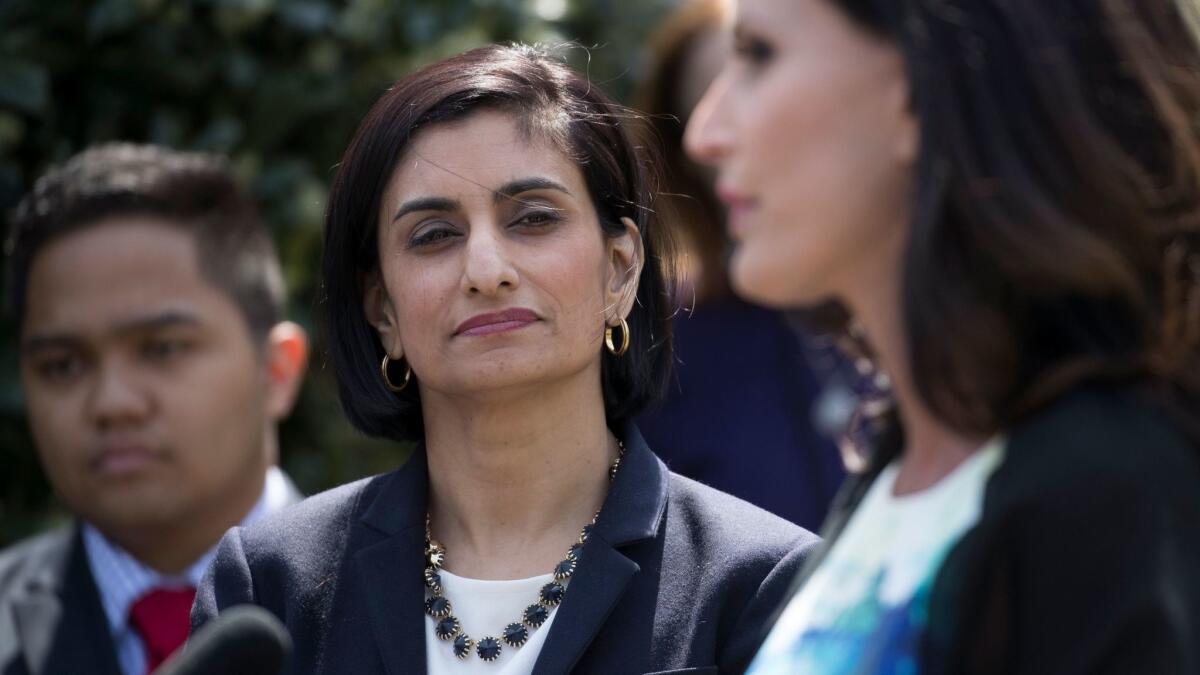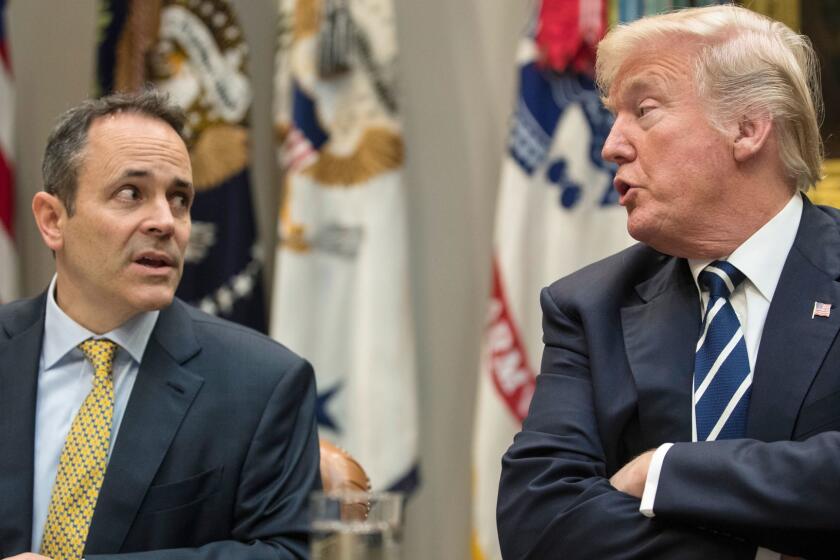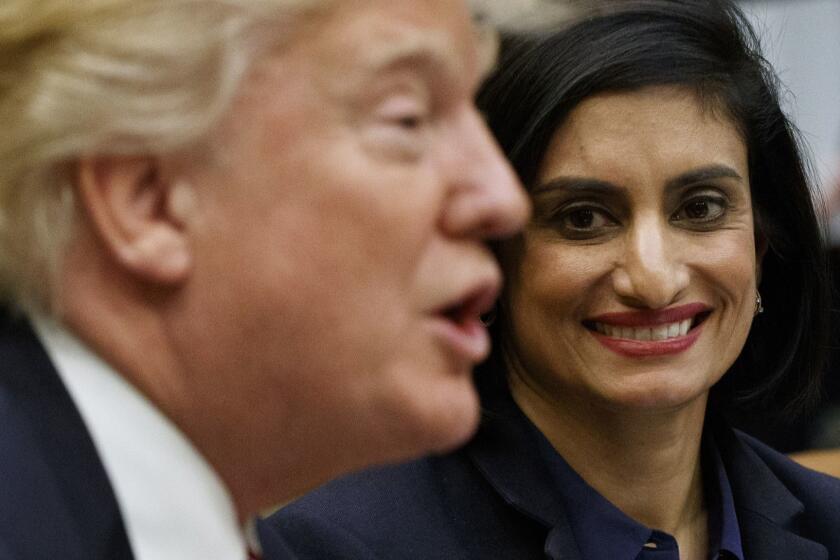Column: Despite almost no evidence of abuse, Trump plans to narrow Medicaid eligibility

- Share via
For all that President Trump loves to portray himself as a protector of Americans’ healthcare — witness his fatuous new claim to have “saved Pre-Existing Conditions in your Healthcare,” when he’s actually undermined those safeguards — perhaps the most consistent administration healthcare policy has been an attack on Medicaid.
The new year brings the opening of a new front in this war on the government program specifically aimed at bringing coverage to low-income households. The White House says it’s planning to tighten eligibility rules for Medicaid.
That’s a process experts say is likely to raise administrative costs for states, reducing the funds available for medical treatment, and throw potentially millions of people off the program even though they are eligible.
We haven’t seen any compelling data that there’s widespread eligibility fraud.
— Joan Alker, Georgetown University
It’s happening, furthermore, despite the absence of credible evidence that eligibility rules have been abused.
“We haven’t seen any compelling data that there’s widespread eligibility fraud,” says Joan Alker, a leading Medicaid advocate as executive director of the Center for Children and Families at Georgetown University.
The administration’s push for tighter eligibility oversight, however, has states nervous that they’re about to be saddled with onerous new bureaucratic responsibilities.
Red states that imposed Medicaid work requirements have discovered the policy doesn’t work and are reversing course.
State Medicaid officials acknowledge that in a program covering more than 71 million people nationwide, some enrollees may not meet all the economic and categorical qualifications.
But “we don’t see the-sky-is-falling type of stuff,” says Matt Salo, executive director of the National Assn. of Medicaid Directors. His members’ concern, he says, is that the administration will propose “a laser-guided mousetrap for a mouse.”
We’ve reported before on the hostility shown by the Trump administration — and political conservatives generally — for Medicaid.
Based in part on animus shown by conservatives to any program specifically devoted to lower-income residents, it increased sharply after the Affordable Care Act allowed states to expand Medicaid eligibility beyond the traditional population of low-income families with children to include low-income childless adults.
This has led to an unrelenting attack on ostensibly “able-bodied” Medicaid recipients, who are generally depicted as malingerers and layabouts sucking up precious healthcare dollars that should go to the traditional recipients.
Typical of this line was the false claim that Ohio had thrown 34,000 disabled people off its Medicaid rolls to make room for the able-bodied, retailed by right-wing pundit Ben Domenech on the CBS “Face the Nation” news show as its moderator, the evidently uninformed and uninterested John Dickerson, sat silently by.
Seema Verma, the federal official in charge of Medicare, Medicaid and the Affordable Care Act, has blasted into the limelight. And not in a good way.
The banner-carrier for the anti-Medicaid campaign, sadly, has been Seema Verma, who as administrator of the Centers for Medicare and Medicaid Services (CMS) at the Department of Heath and Human Services should be protecting the program, not undermining it.
Verma has happily promoted the “able-bodied” slam and has been in the forefront of the push to impose work requirements on Medicaid recipients, a policy that has been proved not to bring more healthcare to the target population, doesn’t reduce joblessness and has been ruled illegal.
Unsurprisingly, Verma has also been at the forefront of the eligibility issue. In a November speech to the Medicaid directors group in November, she said that “lax eligibility practices jeopardize the sustainability of the program” and hinted that her agency had compiled “deeply concerning” figures on enrollment of ineligible persons.
Though she didn’t produce the figures and acknowledged that the CMS survey had covered only one-third of the states, she said the review had “identified deficiencies” and added: “That sound you hear is the screeching of the canary in the coal mine.”
Verma justified her concern by asserting that Medicaid accounts for 30% of state budgets. In other words, she was aiming to protect states’ taxpayers, not just federal.
As it happens, this is an utterly bogus and highly dishonest statistic. It treats the amount the federal government pays for this federal-state program as if it’s state money. That’s tantamount to double-counting, since Medicaid is the largest source of federal dollars flowing to states, as Salo observes.
The latest bad news for Medicaid work requirement: They are a failure in policy terms (unless the policy goal is to throw people off Medicaid).
The actual share of nonfederal state funds devoted to Medicaid, according to the federal government’s own figures, is about 16%. Given that one of government’s primary duties is to sustain its most vulnerable populations, does that sound excessive?
Soon after Verma’s speech, CMS published a 300-page report on financial measures, showing an improper-payment rate of 8.36% based on eligibility. But a close reading showed that the vast majority of those cases were ruled improper because of bureaucratic technicalities, not fraud.
Fewer than one-tenth of the improper payments were connected to patients who “were determined to be ineligible for Medicaid or the benefit provided,” the Georgetown Health Policy Institute‘s Kelly Whitener reported.
In other words, the actual rate of improper eligibility may be less than 0.83%. In any event, total enrollment in Medicaid has been falling — reaching 71.4 million in the third quarter of 2019, from a post-ACA peak of 75.1 million in early 2016. (The pre-ACA monthly average was about 56.5 million.)
These four charts trace the sudden improvement in health coverage for individuals in Obamacare
The CMS report generated vigorous responses on the right, including an op-ed in the Wall Street Journal by a former Trump administration advisor and a fellow at the Cato Institute. They asserted that, according to their own “new research, ... between 2.3 million and 3.3 million people with income above eligibility thresholds ... are enrolled in Medicaid in expansion states.”
They wrote that “there are some areas, such as New York City and Los Angeles, where the problem appears so large that it suggests purposeful and fraudulent abuse on the part of local officials and the medical industry.”
The Cato-affiliated co-author, Aaron Yelowitz of the University of Kentucky, told me by email that a series of audits by the HHS inspector general and state officials in Louisiana, Oregon and Montana “highlight the serious problem of improper enrollment.”
That those audits necessarily point to a surge in ineligible enrollees has been questioned by other scholars. The inspector general audits generally start from a small sample and extrapolate aggressively.
An audit of California Medicaid (or Medi-Cal), for instance, was based on a sample of 150 enrollees out of a Medi-Cal population of 13.4 million; it determined that anywhere from 260,000 to 630,000 Californians might have been improperly enrolled--a rate of 1.9% to 4.7%. But it didn’t conclude that all the improperly enrolled people were ineligible--just that the state’s verification systems were faulty. The state said that the systems had been upgraded after the sample period, which was October 2014 through March 2015, near the launch of Medicaid expansion.
Critics of Yelowitz’s papers also asserted that eligibility for Medicaid isn’t always evident from gross or taxable income of enrollees, since some income sources aren’t counted for eligibility and low-income people often have volatile earnings, shifting them in and out of the eligibile class. Yelowitz says his studies were adjusted to minimize those issues.
Medicaid officials say they take their responsiblities as stewards of taxpayer funds seriously, but that rigorous enforcement of complicated rules can do little more than discourage the enrollment of eligible beneficiaries while producing minimal savings--”a pound of prevention for an ounce of cure,” in Salo’s words.
What’s really behind the eligibility drive? Alker sees it as part of a broader campaign “designed to reinforce negative stereotypes about Medicaid recipients” and a means to make states nervous about spending on the program. That’s a phenomenon that’s likely to prompt some states to cut back on the scope of their Medicaid programs.
What’s lost in this discussion is how crucial Medicaid has become to American families at the lower end of the economic ladder. The program now pays for roughly half of all births in the United States (more than 60% across the South, which remains a nest of anti-expansionism). It covers 62% of all nursing home residents, and is the largest single source of payment for mental health services.
“We cover all these things because nobody else wants to,” says Salo.
Under the circumstances, shouldn’t the administration have better backup for its claim that eligibility fraud is an issue than bogus numbers and ideological animosity?
More to Read
Inside the business of entertainment
The Wide Shot brings you news, analysis and insights on everything from streaming wars to production — and what it all means for the future.
You may occasionally receive promotional content from the Los Angeles Times.













